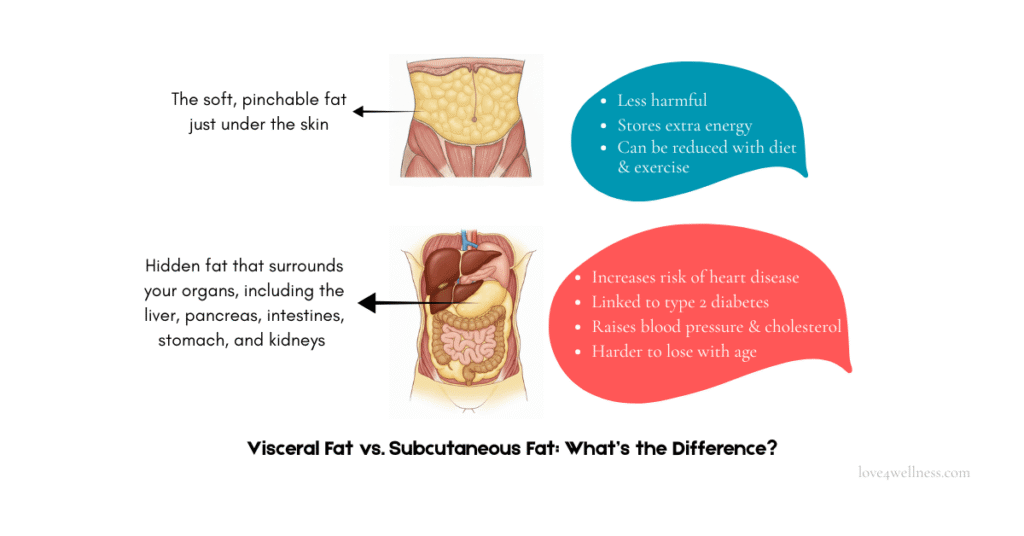You may be surprised to know the “middle-age spread” isn’t just a part of aging; it’s a sign of increasing visceral fat—the type of fat that wraps tightly around your organs, unlike the fat under your skin. Exploring the reasons for visceral fat in men over 40 is crucial, as this fat, found deep in the abdomen, is linked to serious health risks like heart disease, diabetes, and some cancers.
But if you’re exercising and eating the same way you always have, why is your body suddenly changing? The truth is, your body in your 40s is fundamentally different from your body in your 20s. Visceral fat doesn’t just appear—it results from several biological and lifestyle shifts that occur with age.
Here are the 7 key reasons why men develop visceral fat after 40.

1. Hormonal Shifts in Testosterone
After age 30, a man’s testosterone levels begin to decline by about 1% each year. Testosterone is a crucial hormone that regulates fat distribution and promotes muscle growth and development. As levels drop, men lose lean muscle and gain more fat—especially visceral fat. Lower testosterone also slows metabolism, making weight gain even easier.
2. Muscle Loss (Sarcopenia) and a Slower Metabolism
Your body’s metabolism is directly linked to its muscle mass. Muscle tissue is metabolically active, meaning it burns more calories at rest than fat tissue does. As men lose muscle mass with age—a condition known as sarcopenia—their metabolism slows down significantly. This means you’re burning fewer calories throughout the day, making it easy for excess calories to be stored as visceral fat.
3. Rising Cortisol Levels from Chronic Stress
The 40s and 50s are often a period of peak career pressure, financial strain, and family responsibilities. This chronic stress can lead to constantly elevated levels of cortisol, your body’s primary stress hormone. High cortisol specifically promotes the storage of visceral fat and increases appetite, making you more likely to crave unhealthy, high-calorie foods.
4. Insulin & Leptin Resistance: A Double Challenge
As men age, their bodies can become less sensitive to insulin, the hormone that regulates blood sugar levels. When your cells become insulin-resistant, they can’t effectively absorb glucose from your bloodstream for energy. This can cause blood sugar spikes even in people without diabetes, leading to higher blood sugar, which the body then converts into fat and stores—you guessed it—right in the abdomen as visceral fat.
But insulin isn’t the only hormone affected. Visceral fat also disrupts another key hormone: leptin. Leptin’s job is to signal your brain that you are full. However, as visceral fat cells produce more inflammatory signals, they can lead to leptin resistance. This means your brain doesn’t receive the “stop eating” message, which leaves you feeling constantly hungry and makes you more likely to overeat.
5. Inadequate Sleep
Getting less than 7-8 hours of sleep per night makes it harder to fight fat gain. Lack of sleep upsets hunger hormones: it raises ghrelin (“go-hungry” hormone) and lowers leptin (“stop-eating” hormone). This makes you hungrier and more likely to store fat, particularly in the abdominal area.
6. A More Sedentary Lifestyle
Your life in your 40s is likely less active than it was in your 20s. Long hours at a desk, a longer commute, and less time for sports or hobbies all contribute to a significant drop in your daily physical activity. This sedentary lifestyle means you’re burning far fewer calories than you used to, allowing them to accumulate as fat.
7. Dietary Habits That Catch Up
Many men in their 40s still eat like they did in their 20s: processed foods, excess carbs, alcohol, and late-night meals. But with a slower metabolism and less muscle, these habits are no longer easy to burn off. Instead, they add directly to visceral fat.
Final Thoughts
Visceral fat doesn’t appear overnight. It’s the result of a perfect storm of age-related hormonal shifts and lifestyle habits that together create an ideal environment for fat storage around your organs.
The good news is that you have the power to reverse this. Understanding these root causes is the first step toward developing a comprehensive plan that addresses all seven of these factors simultaneously.
